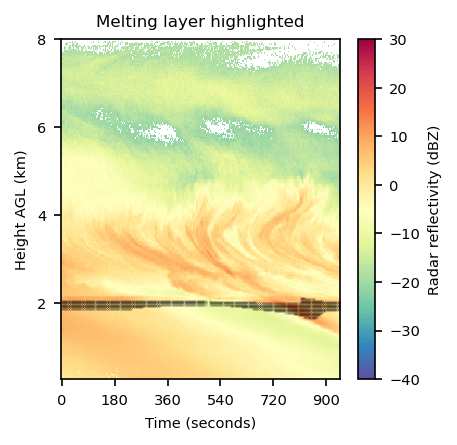About me
Hello, welcome to my personal website. I am a recent PhD Graduate at University of Michigan with my research focused on hydrometeorology, machine learning, and remote sensing. Our recent research, advised by Dr. Fraser King, Prof. Claire Pettersen, and Prof. Mark Flanner, investigates machine learning-boosted detection of melting layers from profiling radar observations.
CV
Learn more about my research experiences here CV, including my previous work on atmospheric radiation and satellite remote sensing.
Publication
Xie, Y., King, F., Pettersen, C., & Flanner, M. (2025). Machine learning detection of melting layers from radar observations Journal of Geophysical Research: Machine Learning and Computation, 2, doi:10.1029/2024JH000521
Xie, Y., Pettersen, C., Flanner, M., & Shates, J. (2024). Ground-observed snow albedo changes during rain-on-snow events in northern Alaska. Journal of Geophysical Research: Atmospheres, 129, doi:10.1029/2024JD040975
Liu, Y., Huang, Y., Yuan, J., Xie, Y., & Zhou, C. (2024). Contribution of surface radiative effects, heat fluxes and their interactions to land surface temperature variability. Journal of Geophysical Research: Atmospheres, 129, doi:10.1029/2023JD039495
Xie, Y., Huang, X., Chen, X., L’Ecuyer, T. S., & Drouin, B. J. (2023). Joint use of far-infrared and mid-infrared observation for sounding retrievals: Learning from the past for upcoming far-infrared missions. Earth and Space Science, 10, doi:10.1029/2022EA002684
Xie, Y., Huang, X., Chen, X., L’Ecuyer, T. S., Drouin, B. J., & Wang, J. (2022). Retrieval of Surface Spectral Emissivity in Polar Regions Based on the Optimal Estimation Method. Journal of Geophysical Research: Atmospheres, 127, doi:10.1029/2021JD035677
L’Ecuyer, T. S., Drouin, B. J., Anheuser, J., Grames, M., Henderson, D. S., Huang, X., Kahn, B. H., Kay, J. E., Lim, B. H., Mateling, M., Merrelli, A., Miller, N. B., Padmanabhan, S., Peterson, C., Schlegel, N., White, M. L., & Xie, Y. (2021). The Polar Radiant Energy in the Far Infrared Experiment: A New Perspective on Polar Longwave Energy Exchanges, Bulletin of the American Meteorological Society, 102(7), doi:10.1175/bams-d-20-0155.1
Huang, Y., Chou, G., Xie, Y., & Soulard, N. (2019). Radiative Control of the Interannual Variability of Arctic Sea Ice. Geophysical Research Letters, 46, 9899– 9908, doi:10.1029/2019gl084204
ClickCollect
ClickCollect allows you to choose graph features via mouse clicks and convert chosen pixels into data points. It is interactive so you can re-adjust the chosen pixels and determine when to finish. This tool is a by-product of the ML2 project, originally designed to collect melting layer information from radar observations. We think ClickCollect can be useful in many other applications, and therefore happily post it on GitHub
A video demo of ClickCollect application on radar observations
ML2: Machine Learning based Melting Layer detection
Melting layers signify the height where transition from solid to liquid precipitation occurs, and generate distinctive signatures in radar observations. This ongoing project aims to develop a machine learning based method for automatic detection of melting layers from Atmospheric Radiation Measurement (ARM) radar observations. Below shows an example on May 26, 2015 from 00:55:40 to 01:11:26 UTC.


ROSA: Rain-on-snow events in northern Alaska
As climate warms, rain-on-snow events will become more frequent and intense along the northern Alaska. This study leverages multi-year Atmospheric Radiation Measurement (ARM) ground observations to investigate rain-on-snow events in northern Alaska and their impacts on accelerating surface snow melting. Large-scale environmental analyses reveal difference moisture sources for rain-on-snow onsets. Check the paper for more.
Satellite remote sensing of surface properties
In preparation for the PREFIRE mission (Polar Radiant Energy in the Far-InfraRed Experiment), this study develops and evaluates an optimal-estimation based algorithm to retrieve mid-infrared and far-infrared polar surface emissivity. Check the paper for more.
The remote sensing algorithm is later improved and applied on IRIS-D satellite observations to simultaneously retrieve atmospheric profiles and surface properties, which demonstrates the importance of surface spectral emissivity to humidity and temperature retrievals in the lower troposphere. Check the paper for more.
Contribution of radiative fluxes to the atmospheric variability
The Arctic Sea Ice Extent (SIE) declines at an intriguingly fast rate and exhibits a strong variability. This work demonstrates that the interannual variability of September Arctic SIE is strongly driven by radiative fluxes in earlier summer months. This work is led by Prof. Yi Huang, check the paper for more.
I participated in the aforementioned project at Montreal and later continued to work on relevant research topic for my undergraduate thesis back in China with Prof. Chen Zhou. This piece of work was later incorporated into a study that interprets the global land surface temperature variability with contributions of radiative and heat fluxes. This study is led by Yincheng, check the paper for more.
